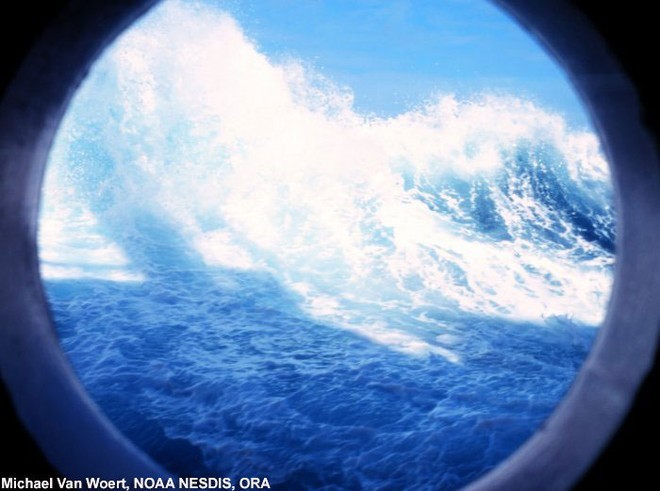Science Speaks- Rogue Waves are Real
by Live Science/Sail-World on 2 Dec 2008

Rogue wave approaching on ship Nathaniel B Palmer SW
Every year sound sailing boats, well equipped with safety gear, with experienced crew on board, go missing. Their loved ones are forever left wondering: Was it a whale? a floating container? a rogue wave?
In the past, some scientists wrote off 'rogue waves' as rare or even mythology.
However, satellite data collected by the European Space Agency's (ESA) ERS satellites has confirmed what too many ship captains have come to know (and occasionally captured photographs). Ocean waves that rise as tall as ten-story apartment buildings are a leading cause of large ship sinkings.
The Norwegian Dawn, a 965-foot ocean liner , was sailing back to New York from the Bahamas on April 16 2005 when it was struck by a rogue 70-foot wave. The wave smashed windows and sent furniture flying, but the ship survived and the crew lived to record the wave's arrival.
A sailing boat faced with such a wave would have little chance of survival, and if it came at night, maybe not even the chance to hit the EPIRB.
A giant wave can form when strong winds beat against an opposing ocean current, when waves from different storms join forces, or when swells interact in strange ways with a particular seafloor.
Since 2005, Vijay Panchang at the A&M University at Galveston in Texas and his associates say they can accurately predict the daily height of waves anywhere off the coast of the United States for the next 48 hours across spaces as close as 500 yards apart.
A buoy off the coast of Alabama recently recorded an average wave height of 16 meters before the gauge broke, Panchang said. Since that figure is just an average of measurement of a sea-state, the biggest wave at that location was probably twice that size--32 meters, or about 100 feet.
'There were oil platforms destroyed,' said Panchang, who requires his wave mechanics students to read The Perfect Storm. 'The sheer magnitude of these things amazes me.'
Severe weather has sunk more than 200 supertankers and container ships more than 200 yards long in the past two decades, an ESA analysis found.
Counting waves from space:
The two ERS satellites equipped with radar carry out a global rogue wave census and arrive at the truth.
Without aerial, cloud-penetrating radar, scientists could only go on radar data on waves collected from oil platforms.
The radar instruments on the satellites detected the height of individual waves at the surface in 3-mile by 6-mile patches of the sea. Three weeks of data, including 30,000 of these patches or 'imagettes' of the sea with their wave height information were analyzed and searched for extreme waves at the German Aerospace Center.
A scientific team counted more than ten individual giant waves around the globe more than 75 feet high during the three-week period.
What can the cruising sailor do?
There are a few things that long range cruisers can do when setting off, apart from the obvious ones like never travelling close to a cyclone season, taking particular note of existing currents, and watching the weather like your life depends on it - because it does.
If there are different swells meeting, the other most obvious rule is to stay away from underwater mountains and ranges, where rogue waves are likely to develop if other conditions accumulate. There are many examples of underwater disturbances on the world's charts, eg. between Madeira and the Canary Islands, between Sydney and Lord Howe Island, and between Palmerston Atoll and Tonga.
Another underwater feature to be avoided is the underwater cliff, which often occurs close to coastlines. One of the most notorious of these is in the Bay of Biscay, where the depth changes from thousands of meters to a few hundred in a short distance.
To find examples of Vijay Panchang's wave predictions, which do not exist for all parts of the world, click here
If you want to link to this article then please use this URL: www.sail-world.com/51411